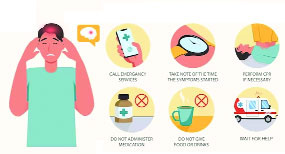What to do to avoid risk
Dangers of Heatstroke
Professor Dr. ABM Abdullah: Heavy fire is spreading across the country, heat is increasing. In some parts of the country, the temperature exceeded 43 degrees Celsius. All over the country panting and panting in the heat, people and animals are disorientated by the heat.
Apart from this, many people are suffering from various diseases. However, the risk of heatstroke increases in a few days.
What is Heatstroke: Heatstroke is a serious health problem during summer. According to medical science, when the body temperature exceeds 105 degrees Fahrenheit, the body’s ability to regulate heat in hot weather ceases to sweat and the person may faint, known as heatstroke. Blood plays a role in normal body temperature regulation. When the body temperature rises for some reason, the blood vessels in the skin dilate and dissipate the excess heat to the environment. When the heat increases, the body also starts sweating, when the sweat evaporates, the body cools down, and the body heat is reduced through sweating. But if you stay or work for a long time in a very hot and humid environment, heat control is no longer possible. In this, the body temperature quickly exceeds the danger limit, the envelope closes and heat
A stroke occurs
Who is more likely to get heat stroke: Anyone can get heat stroke in extreme heat and humidity. However, in some cases the possibility of heatstroke increases. For example-
- Children and the elderly are less likely to have heatstroke due to their poor thermoregulation. In addition, since elderly people often suffer from various diseases such as high blood pressure, diabetes, kidney, liver or heart patients, those who suffer from stroke or cancer-related diseases, even those who have low immunity for any reason or take various medications, which increases the risk of heatstroke.
- Those who do physical work in the hot sun during the day are at a higher risk of heatstroke. Such as farmers, laborers, rickshaw pullers.
- Dehydration increases the risk of heat stroke.
- Certain medications increase the risk of heatstroke, especially diuretics, antidepressants, psychiatric medications, etc.
What are the symptoms of heatstroke: As the temperature rises, various reactions occur in the body. Initially, heatstroke may be preceded by less severe heat cramps or heat exhaustion. Heat cramps cause muscle aches, weakness and extreme thirst. The next step in heat exhaustion is rapid breathing, headache, dizziness, nausea, incoherent behavior, etc. In both these cases the body heat regulation is fine and the body sweats profusely. In this situation, heatstroke can occur if quick action is not taken. Its symptoms are: - Body temperature quickly rises above 105 degrees Fahrenheit.
- Sweat stops.
- The skin becomes dry and red.
- Breathing is fast.
- The pulse is weak and rapid.
- Blood pressure decreases.
- Seizures, dizziness, abnormal behavior, hallucinations, incoordination etc.
- The amount of urine decreases.
- The patient also goes into shock. May even faint.
What are the prevention measures: Following some precautions on hot days can avoid the danger of heatstroke. These are- - Wear light, loose clothing. Clothes should be white or light colored. Cotton cloth is better.
- Stay indoors or in the shade as much as possible.
- Use a wide-brimmed hat, cap or umbrella to cover your head when going outside.
- Those who are engaged in outdoor activities, can use an umbrella or something like cloth to cover their head.
- Drink plenty of water and other fluids. Remember, both water and salt come out with sweat in summer. So along with water, you should also drink salty drinks like food saline, fruit juice, lacchi etc. Water must be pure.
- Temperature-raising drinks such as tea and coffee should be consumed as little as possible.
- Avoid doing strenuous work in the sun. If possible, do these things at night or early in the morning. If you have to do it during the day, you should get out of the sun and rest in the shade for a while, drink lots of salted water and saline.
What to do if affected: When heat cramps or heat exhaustion occur initially before heatstroke, heatstroke can be prevented, if necessary, measures are taken. What a person can do in this case is- - Move quickly to a cool place. If possible, leave the fan or AC off.
- Wipe the body with a wet cloth. Take a shower if possible.
- Drink plenty of water and eat saline. Do not drink tea or coffee.
But if heatstroke occurs, the patient must be rushed to the hospital, there is no possibility of treatment at home. In this case, the people around the patient should do the following: - Move the patient to a cool place quickly.
- Undress him.
- Soak the body in water and air it. Keep reducing the temperature like this.
- If possible, apply ice to the shoulders, armpits and groin.
- If patient is conscious, give food saline.
- Arrange for immediate hospital admission.
- Always check for breathing and pulse in an unconscious patient with heatstroke. Artificial respiration and pulse may be provided if necessary. Heatstroke can be life-threatening. The patient may even die. Everyone should be careful during this time of summer. If the necessary measures and proper treatment are taken at the earliest, most of the patients recover completely.
- The risk for children is higher in summer. Children should drink more water. Care should be taken that they do not run too much in the sun.
Everyone should remember to survive this heat by taking proper precautions.
Author: Prime Minister’s personal physician
Rare Israeli airstrike in Beirut kills Hezbollah commander and more than a dozen others
International Desk: Israel launched a rare airstrike that killed a senior Hezbollah milita…








